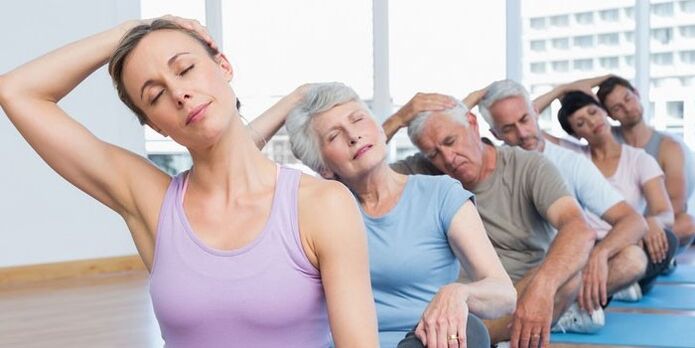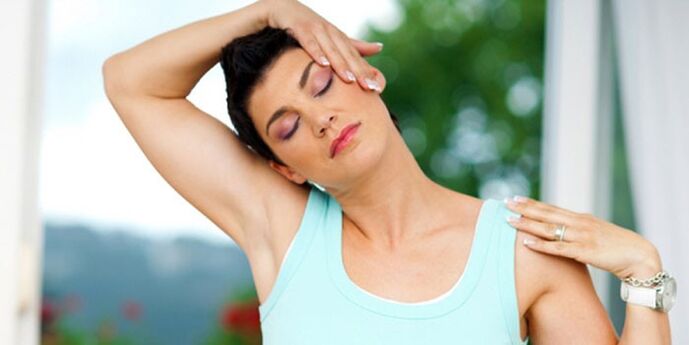Sedentary work, spinal injuries, overweight - there are many reasons why osteochondrosis (dystrophic disorders of the intervertebral discs) can develop. Over the years, pathological lesions develop that gradually feel numb in the hands, a burning sensation between the shoulder blades, neck pain, and other unpleasant symptoms. You can help yourself if you start practicing on time.
The benefits of exercise therapy in osteochondrosis of the cervical spine
Recently, osteochondrosis of the cervical spine has been considered an age-related disease, but today the disease has become much younger and can occur in patients as young as 20-30 years old. It is impossible to completely get rid of dystrophic disorders, but well-chosen treatment significantly improves the patient's quality of life. One of the leaders in the treatment of osteochondrosis is the Therapeutic and Physical Culture Complex (LFK). Simple practice has several benefits:
- They help strengthen the muscular corset, increase muscle tone and elasticity of the ligaments, thus significantly reducing the load on the spine.
- Regular exercises relieve neck pain, headaches, and a burning sensation between the shoulder blades.
- Cervical osteochondrosis gymnastics activates blood flow, reduces the likelihood of stroke, and increases the oxygen supply to the brain.
- Classes in the early stages make it possible to stop the progression of the dystrophic process and improve posture.
Indications and contraindications
Osteochondrosis charging is prescribed during the period of remission, when the pain is reduced. It helps relieve exacerbation, prevents recurrent pain attacks, complications and further destruction of joints. Patients with mild spinal cord injury, diabetes mellitus, arterial hypertension should perform the prescribed exercises in a lightweight version, initially only under the supervision of a doctor or coach.
Exercise should not be started immediately after a meal, on an empty stomach, or after severe physical exertion. Physiotherapy practices are also contraindicated in the following conditions:
- arterial hypertension;
- arrhythmia, tachycardia;
- glaucoma, severe myopia;
- diseases of the vestibular apparatus accompanied by impaired coordination;
- infectious lesions of the spine;
- the period of exacerbation of osteochondrosis;
- aortic aneurysm;
- post-infarction status in the early rehabilitation phase;
- severe spinal cord injuries;
- acute respiratory viral diseases.

Implementing rules
Before you start exercising with osteochondrosis of the neck, it will be useful to get acquainted with the general rules of physical education:
- Exercises should be performed in a well-ventilated area.
- Workout clothing should be loose, free of movement, and uncomfortable.
- Impulse and pressure should be measured before class, and exercise should be refused if these increase.
- To reduce the risk of injury, each movement should be performed smoothly, gradually increasing the load, intensity, and number of repetitions while maintaining posture.
- Gymnastics with cervical osteochondrosis should be performed regularly. Many internships are suitable for work, learning tasks.
- If you experience sharp pain, dizziness, malaise during your gym therapy, stop further training immediately and sit back and relax. Reduce the load in the future and consult a doctor.
- In addition to the exercises, therapeutic massage courses and physiotherapy can also be prescribed.
Exercises for cervical osteochondrosis at home
Therapeutic gymnastics involves performing a series of simple exercises. They can also be performed at home with relaxing music with a medical permit. The main condition is that the spine should be as even as possible, so it is advisable not to lie down but to practice standing or sitting in a chair without backrest. Exercise at the same time each day for a lasting therapeutic effect.
What is warming up for?
Muscle preparation is an important part of any physical activity. A light warm-up helps prevent injuries, warms the muscles, prepares the body for the start of an intense workout, improves blood circulation and stretching. Sample exercise series:
- Sit in a straight-backed chair to relax and lower your arms along your torso. Make circular movements with your shoulders, first forward and then backward. Perform 5-10 reps on each side.
- Stay in the same position, spread your arms parallel to the floor. Inhale, bend your elbows, gently touch your shoulders with your fingertips. Exhale to return to starting position. Make 10 expansions.
- Stand up straight, place your palms on your shoulders, elbows parallel to the floor. After clearing one or two, start alternating circular movements with your elbow. First, connect your left elbow with your right hand, reaching the end of the circle. Do 5 rounds for each hand.
- Take out the starting position as in the first exercise. Pull your arms, start moving your shoulders back and forth. Repeat the procedure 10 times on each side.
Isometric exercises for the neck in osteochondrosis
This complex involves performing all the exercises without moving your head or neck - just using muscle tension. Isometric gymnastics of cervical osteochondrosis is the safest and is therefore prescribed to patients to relieve pain as the disease progresses. All exercises are performed from a posture: standing or sitting in a chair without a back. The duration of a task is 5 seconds, the number of approaches is 2-5. Examples of effective practices:
- Fold your fingers together and place your palms on your forehead. Start pressing your hand on your forehead as if you want to tilt your head, resisting your neck muscles to keep your body still.
- In the same position, move your hand to the back of your head. Press the palm of your hand to perform a micro-movement of the head forward. At the same time, resist the arms with the muscles of the neck and forearms.
- Place your right hand on your face with the palm of your hand. Press your hand to your face and try to tilt your head to the left. At the same time, tighten the muscles, do not allow the head to bend. Do the same exercise with your left hand.
- Stand up, spread your legs shoulder-width apart. Hands sideways, palms out. Tighten the muscles of the neck, arms and back. Fasten your elbows together and backwards, trying to put your hands as far behind your back as possible. Tightening and spreading your elbows is done carefully, without relieving muscle tension and maintaining balance.
dynamic gymnastics
Physical education in cervical osteochondrosis must include exercises to strengthen and increase muscle tone in the upper extremities, neck, shoulder girdle and lower back. That's what dynamic tasks are for. Each is performed at a fast pace, with a 10-15 second pause between sets. You should know that dynamic gymnastics is contraindicated in osteochondrosis, diabetes, spinal cord injuries, and exacerbation of cardiovascular disease.
Approximate series of exercises:
- Stand up straight, put your legs together, put your hands on your waist. Gently tilt your head and try to reach your shoulders with your ears. Perform 5-6 repetitions on each side.
- While sitting or standing, slowly raise your hands and fold your palms together. As you exhale, slowly return to your starting position. Perform 10-15 repetitions.
- Get up, spread your legs, lower your arms along your torso. Perform circular rotations with your shoulders at the same time without raising your arms. Perform 15 circular motions in 3 sets. You can make alternating circles for complexity - first with your left and then your right shoulder.
- While standing, pull your right hand back firmly while raising your left hand at the same time. Perform 10 repetitions and 3 sets for each limb.
- Standing, lower your arms along your torso. Take turns stroking movements, sliding your shoulders as far as you can. Perform the task for 1 minute, then take a break and 2 more series.

A set of exercises for osteochondrosis of the cervical spine
Many rehabilitation physicians have been successful in getting rid of high blood pressure, osteochondrosis, and other health problems through neck exercises. The doctor says his physical education will help improve blood circulation, develop neck and upper spine muscles, and prevent heart attacks and strokes. Cervical osteochondrosis exercise will be useful during the rehabilitation period after surgery or injury, as well as for those who have the following pathologies:
- hypertension;
- drowsiness or insomnia;
- chronic migraine;
- memory impairment.
The author of the technique suggests that all exercises be performed from a sitting position. It is important to keep your back as smooth as possible and not rush, otherwise you will not only not get positive results but will also worsen your condition. To observe your posture, run the program in front of a mirror in the initial stage. The training schedule is as follows: for the first two weeks - every day, then 3-4 workouts per week.
There are certain contraindications to the therapeutic practice of cervical spine osteochondrosis. The tournament cannot be performed with:
- fever, general malaise, weakness;
- exacerbation of osteochondrosis;
- oncological diseases;
- disc herniation;
- during pregnancy;
- infectious and viral diseases;
- risk of internal bleeding.
7 exercises for the neck and shoulders
The complex consists of seven tasks that must be performed while sitting on a chair, without a backrest or other hard surface. All exercises for the treatment of cervical osteochondrosis are shown in the table below:
| The name of the exercise | Starting position | Basic steps | Number of iterations |
|---|---|---|---|
| spring | Sitting in front of a mirror with arms lowered along the body, head straight. | Pull your chin around your neck as far as it will go. Hold for 20 seconds, then gently pull your chin forward and up. After 20 seconds, return to the starting position. | five |
| Metronome | Sitting in front of a mirror with arms lowered along the body, head straight. | Lower your head to the right as far as it will go. Record the position for 10 seconds. Slowly return to the starting position and repeat on the other side. | five |
| A look at the sky | Same | Keep your head straight and your chin parallel to the floor. Gently turn your head to the right to lock in position for 10 seconds. Let’s go back to the beginning and repeat the same on the other side. | five |
| goose | Sitting, arms along body, chin outstretched. | From the starting position, gently turn your head to the right and down and try to reach your shoulders with your chin. Freeze for 10 seconds, then repeat the task on the other side. | 6 |
| Frame | Sitting, right palm on left shoulder, elbow parallel to the floor. | Extend your chin to the shoulder of your right hand. Hold the position for a few seconds. Return smoothly to the starting point. Repeat on the left. | five |
| Fakir | Hands over head with palms. | Turn your neck to the left, keep your chin straight. Freeze for 10 seconds, then return to the beginning. Repeat the exercise on the left. | 7 |
| Boom | Sit in a chair with your back straight. | Straighten your arms and palms toward the floor. Pull them back while pulling your chin forward. Hold your position for 20 seconds. | 4 |
Therapeutic effects and results
Therapeutic practice of osteochondrosis of the cervical spine improves the course of the disease in a short time and cures osteochondrosis with constant performance without medication. It is not at all necessary to complete the full wellness complex of the recommended exercises immediately, beginners can choose the ones they are given without much effort and gradually increase the volume. Training should not be stopped after the therapeutic effects have been achieved, and improvement should be maintained.
In the absence of severe contraindications, you can tighten the spine on the horizontal band. Such an exercise helps to replace the intervertebral discs, gives impetus, strengthens the muscular corset. Suitable for swimming, dancing, light fitness, yoga or aerobics. To prevent osteochondrosis and complete recovery, doctors recommend maintaining an active lifestyle and organizing the work area appropriately.
























